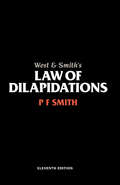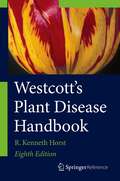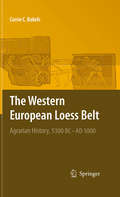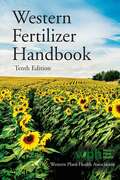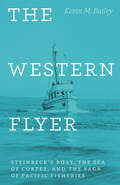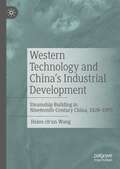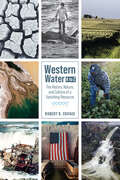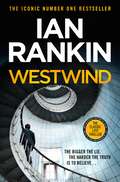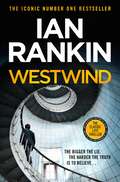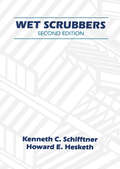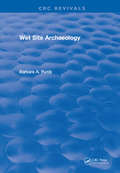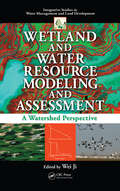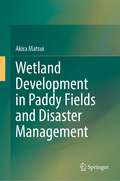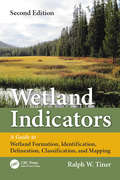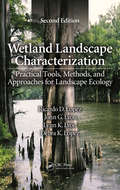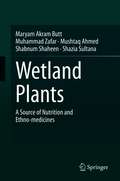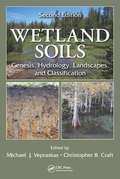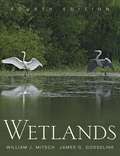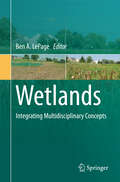- Table View
- List View
West & Smith's Law of Dilapidations
by PF Smith William Anthony WestDiscusses the legal principles governing dilapidated premises. This book examines the express implied and statutory repairing obligations of landlord and tenants. It looks at the remedies which are available to both parties to a lease if a repairing obligation is broken. It is useful for both professionals and students in the dilapidations field.
West with the Night
by Beryl MarkhamWest with the Night is the story of Beryl Markham--aviator, racehorse trainer, beauty--and her life in the Kenya of the 1920s and '30s. Beryl Markham is also the author of The Splendid Outcast: The African Stories of Beryl Markham. Growing up in East Africa, the author describes her life as a pioneer aviator, a horse breeder, pilot of passengers and supplies in a small plane to remote corners of Africa. "Did you read Beryl Markham's book, West with the Night? I knew her fairly well in Africa and never would have suspected that she could and would put pen to paper except to write in her flyer's log book. As it is, she has written so well, and marvelously well, that I was completely ashamed of myself as a writer. I felt that I was simply a carpenter with words, picking up whatever was furnished on the job and nailing them together and sometimes making an okay pig pen. But [she] can write rings around all of us who consider ourselves writers. The only parts of it that I know about personally, on account of having been there at the time and heard the other people's stories, are absolutely true . . . I wish you would get it and read it because it is really a bloody wonderful book. "--Ernest Hemingway
Westcott's Plant Disease Handbook
by R. Kenneth HorstWestcott's Plant Disease is a reference book on diseases which attack plants. Diseases of plants are found on most all plants including trees, shrubs, grasses, forage, fruits, vegetables, garden and greenhouse plants as well as native wild flowers and even weeds. Plant Disease Handbook identifies various types of diseases which are known to invade these plants located throughout North and South America. The recordings include diseases caused by fungi, bacteria, viruses, viroids and nematodes. Causal disease agents are described and illustrated in many cases and diseases and disease control measures are also discussed. A book such as this is never finished since new reports of diseases are continuously reported. This includes new diseases and previously known diseases which occur on both presently recorded plants and on new plants found to be susceptible to diseases. Westcott's Plant Disease provides a reference and guide for identification and control of these plant disease problems.
The Western European Loess Belt
by Corrie C. BakelsThis book deals with the early history of agriculture in a defined part of Western Europe: the loess belt west of the river Rhine. It is a well-illustrated book that integrates existing and new information, starting with the first farmers and ending when food production was no longer the chief source of livelihood for the entire population. The loess belt was chosen because it is a region with only one type of soil and climate as these are all-important factors where farming is concerned. Subjects covered are crops, crop cultivation, livestock and livestock handling, the farm and its yard, and the farm in connection with other farms. Crop plants and animals are described, together with their origin. New tools such as the plough, wheen, wagon and scythe are introduced. Groundplans of farm buildings, the history of the outhouse and the presence or absence of hamlets are presented as well, and the impact of farming on the landscape is not forgotten. The loess belt was not an island and the world beyond its boundaries was important for new ideas, new materials and new people. Summarising six millennia of agriculture, the thinking in terms of the Western European loess belt as one agricultural-cultural unit seems justified.
Western Fertilizer Handbook
by Western Plant Health AssociationFor almost 70 years, agronomists throughout the western United States have relied on the Western Fertilizer Handbook for the most accurate information to maintain efficient and profitable growing programs. <p><p>The Tenth Edition carries this tradition forward with continued emphasis on sustainable uses of fertilizers. The expert team of contributors has updated the book's content to address current challenges facing western agriculture. Additional material has been added on micro-irrigation; soil, water, and tissue analysis; remote sensing of crop nutrient and water status; and agronomic decision support software.
The Western Flyer: Steinbeck's Boat, the Sea of Cortez, and the Saga of Pacific Fisheries
by Kevin M. BaileyIn January 2010, the Gemini was moored in the Swinomish Slough on a Native American reservation near Anacortes, Washington. Unbeknownst to almost everyone, the rusted and dilapidated boat was in fact the most famous fishing vessel ever to have sailed: the original Western Flyer, immortalized in John Steinbeck's nonfiction classic The Log from the Sea of Cortez. In this book, Kevin M. Bailey resurrects this forgotten witness to the changing tides of Pacific fisheries. He draws on the Steinbeck archives, interviews with family members of crew, and more than three decades of working in Pacific Northwest fisheries to trace the depletion of marine life through the voyages of a single ship. After Steinbeck and his friend Ed Ricketts--a pioneer in the study of the West Coast's diverse sea life and the inspiration behind "Doc" in Cannery Row--chartered the boat for their now-famous 1940 expedition, the Western Flyer returned to its life as a sardine seiner in California. But when the sardine fishery in Monterey collapsed, the boat moved on: fishing for Pacific ocean perch off Washington, king crab in the Bering Sea off Alaska, and finally wild Pacific salmon--all industries that would also face collapse. As the Western Flyer herself faces an uncertain future--a businessman has bought her, intending to bring the boat to Salinas, California, and turn it into a restaurant feature just blocks from Steinbeck's grave--debates about the status of the California sardine, and of West Coast fisheries generally, have resurfaced. A compelling and timely tale of a boat and the people it carried, of fisheries exploited, and of fortunes won and lost, The Western Flyer is environmental history at its best: a journey through time and across the sea, charting the ebb and flow of the cobalt waters of the Pacific coast.
Western Political Thought: மேற்கத்திய அரசியல் சிந்தனை
by R. Thangarajஅமெரிக்கா உட்பட உலகெங்கிலும் உள்ள அரசாங்கங்களுக்கு மேற்கத்திய அரசியல் சிந்தனை ஒரு தத்துவ மற்றும் கருத்தியல் அடித்தளமாக செயல்பட்டுள்ளது. சமகால அரசியல் சமூகத்துடன் தொடர்புபடுத்த வரலாற்று, சமூக மற்றும் கலாச்சார சூழலை நாங்கள் உங்களுக்கு வழங்குகிறோம்.
Western Technology and China’s Industrial Development: Steamship Building in Nineteenth-Century China, 1828-1895
by Hsien-ch'un WangThis book explores how steam engine technology was transferred into nineteenth-century China in the second half of the nineteenth century by focusing on the transmission of knowledge and skills. It takes on the long-term problem in historiography that puts too much emphasis on politics but ignores the techno-scientific and institutional requirements for launching such an endeavor. It examines how translations broke linguistic and conceptual barriers and brought new a understanding of heat to the Chinese readership. It also explores how the Fuzhou Navy Yard’s shipbuilding and training program trained China’s first generation of shipbuilding workers and engineers. It argues that conservatism against technology was not to blame for China’s slow development in steamship building. Rather, it was government officials’ failure to realize the scale of institutional and techno-scientific changes required in importing and disperse new knowledge and skills.
Western Union and the Creation of the American Corporate Order, 1845-1893
by Joshua D. WolffThis work chronicles the rise of Western Union Telegraph from its origins in the helter-skelter ferment of antebellum capitalism to its apogee as the first corporation to monopolize an industry on a national scale. The battles that raged over Western Union's monopoly on nineteenth-century American telecommunications - in Congress, in courts, and in the press - illuminate the fierce tensions over the rising power of corporations after the Civil War and the reshaping of American political economy. The telegraph debate reveals that what we understand as the normative relationship between private capital and public interest is the product of a historical process that was neither inevitable nor uncontested. Western Union's monopoly was not the result of market logic or a managerial revolution, but the conscious creation of entrepreneurs protecting their investments. In the process, these entrepreneurs elevated economic liberalism above traditional republican principles of public interest and helped create a new corporate order.
Western Water A to Z: The History, Nature, and Culture of a Vanishing Resource
by Robert R. CrifasiWestern Water A to Z is the first ever field guide to Western water. Reinventing this twentieth-century genre for a twenty-first-century audience, Robert R. Crifasi answers questions about rivers, water projects, the culture of water, the ecosystems water projects have created or destroyed, and the reliance of cities, farms, and industries on this critical resource. Organized as a collection of terms, the book addresses the most salient water issues and provides helpful background information regarding their origins and implications. Photographs serve a vital role in the cultural dialogue on water and stand as an equal partner to the text. Each subject is covered in about one page and is accompanied by one or two striking images from famous photographers like Margaret Bourke-White, Carleton E. Watkins, Arthur Rothstein, William Henry Jackson, and Dorothea Lang as well as Crifasi’s own work. Water often finds itself at the center of our cultural discourse in art, cinema, and literature, which play essential roles in shaping our understanding and experience of Western water. Crifasi also engages personalities that are nearly synonymous with Western water—John Wesley Powell, Elwood Mead, and Floyd Dominy, among others—to show how their lives intertwined with and often influenced the course of water development across the region. Travelers, adventurers, students, and anyone interested in water will find Western Water A to Z a handy and entertaining reference guide.
Westwind: The classic lost thriller
by Ian RankinTHE CLASSIC LOST THRILLER FROM THE ICONIC NUMBER ONE BESTSELLER'Shockingly good' The Sun'A prescient, high-octane thriller' Daily Express'Totally on the money - and ripe for this republication' i Newspaper * * * * *It always starts with a small lie. That's how you stop noticing the bigger ones.After his friend suspects something strange going on at the satellite facility where they both work - and then goes missing - Martin Hepton doesn't believe the official line of "long-term sick leave"...Refusing to stop asking questions, he leaves his old life behind, aware that someone is shadowing his every move. But why?The only hope he has is his ex-girlfriend Jill Watson - the only journalist who will believe his story.But neither of them can believe the puzzle they're piecing together - or just how shocking the secret is that everybody wants to stay hidden...DISCOVER THE CLASSIC LOST THRILLER FROM THE ICONIC NUMBER ONE BESTSELLER.* * * * *'Rankin is a master storyteller'Guardian'Great fiction, full stop'The Times'Ian Rankin is a genius'Lee Child'One of Britain's leading novelists in any genre'New Statesman'A virtuoso of the craft'Daily Mail'Rankin is a phenomenon'Spectator'Britain's No.1 crime writer'Mirror'Quite simply, crime writing of the highest order'Express'Worthy of Agatha Christie at her best'Scotsman
Westwind: The classic lost thriller
by Ian RankinIt always starts with a small lie. That's how you stop noticing the bigger ones.After his friend suspects something strange going on at the launch facility where they both work - and then goes missing - Martin Hepton doesn't believe the official line of "long-term sick leave"...Refusing to stop asking questions, he leaves his old life behind, aware that someone is shadowing his every move.The only hope he has is his ex-girlfriend Jill Watson - the only journalist who will believe his story.But neither of them can believe the puzzle they're piecing together - or just how shocking the secret is that everybody wants to stay hidden...A gripping, page-turning suspense masterclass - experience the brilliance of the iconic Ian Rankin.
Wet Scrubbers
by Howard D. HeskethA basic technical book on the design and application of gas cleaning technologies that use liquids, first published in the 1980's and used by plant and environmental engineers, regulatory personnel, and others concerned with air pollution. The second edition enlarges the discussion on the theory of
Wet Site Archaeology
by Barbara A. PurdyThis volume, the result of an International Conference on Wet Site Archaeology funded by the National Endowment for the Humanities, explores the rewards and responsibilities of recovering unique assemblages from water-saturated deposits. Characteristics common to all archaeological wet sites are identified from Newfoundland to Chile, Polynesia to Florida, and from the Late Pleistocene to the Twentieth Century. Topics include innovative excavation and preservation methods; the need for adequate funding to preserve and analyze the abundant biological and cultural remains recovered only at archaeological wet sites; expanded knowledge of past environments, subsistence, technologies, artistic expressions, skeletal structure, and pathologies; the urgency to inform developers and governmental bodies about the invisible heritage entombed in wetlands that is often destroyed before it can be investigated; a formula for establishing priorities for excavating wet sites; and how to determine when enough of a wet site has been sampled.Many famous sites and discoveries are described in this volume, including Herculaneum, Hoko River, Hontoon Island, Key Marco, Monte Verde, Ozette, Somerset Levels, Windover, bog bodies of Northern Europe, and lake dwellers of Switzerland. Professional and amateur archaeologists, as well as anyone interested in archaeology or the significance of wet site archaeology will find this book fascinating.
Wet-Weather Flow in the Urban Watershed: Technology and Management
by Richard Field Daniel SullivanAccording to the National Resources Defense Council, stormwater runoff rivals or exceeds discharges from factories and sewage plants as a source of pollution throughout the United States. The Environmental Protection Agency identifies urban stormwaters as the second largest source of water quality damage in estuaries and a significant contributor t
Wetland and Water Resource Modeling and Assessment: A Watershed Perspective
by Wei JiAs a wetland of international importance located in China, the Poyang Lake Basin's incredible topographical and biological diversity has provided a congregating point for scientists from around the world to engage in cross-disciplinary research. In particular, the International Conference on Poyang Lake Complex Environment System was instrumental i
The Wetland Book: Distribution, Description, And Conservation
by Mark Everard Beth A. Middleton C. Max Finlayson Nick C. Davidson Kenneth Irvine Robert J. McInnes Anne A. van DamThe Wetland Book is a comprehensive resource aimed at supporting the trans- and multidisciplinary research and practice which is inherent to this field. Aware both that wetlands research is on the rise and that researchers and students are often working or learning across several disciplines, The Wetland Book is a readily accessible online and print reference which will be the first port of call on key concepts in wetlands science and management. This easy-to-follow reference will allow multidisciplinary teams and transdisciplinary individuals to look up terms, access further details, read overviews on key issues and navigate to key articles selected by experts
The Wetland Book: Distribution, Description, And Conservation
by C. Max Finlayson G. Randy Milton R. Crawford Prentice Nick C. DavidsonThe Wetland Book is a comprehensive resource aimed at supporting the trans- and multidisciplinary research and practice which is inherent to this field. Aware both that wetlands research is on the rise and that researchers and students are often working or learning across several disciplines, The Wetland Book is a readily accessible online and print reference which will be the first port of call on key concepts in wetlands science and management. This easy-to-follow reference will allow multidisciplinary teams and transdisciplinary individuals to look up terms, access further details, read overviews on key issues and navigate to key articles selected by experts.
Wetland Development in Paddy Fields and Disaster Management
by Akira MatsuiThis book proposes the use of green infrastructure to balance biodiversity conservation and disaster management. Paddy fields are one example of such infrastructure and are the focus of this book. In Japan, abandoned, once-cultivated land is increasing in the paddy fields due to the aging of society and recent depopulation. The author proposes to consolidate such lands and create wetlands because the paddy fields hold water during heavy rains, which prevents floods and protects cities. This is essential, considering that extreme weather conditions have increased the risk of flood damage in Japan. Not only do such wetlands hold water during the flood season, they also provide habitats for aquatic life and places for children to learn about the natural environment. In addition, fish farming in the wetlands will provide food for many people. The increase in water disasters associated with global warming is occurring not only in Japan but globally. The proposal presented in this book will help government officials around the world, especially those involved in urban and rural planning, to consider disaster management—an idea that will be welcomed by both engineers and biologists.
Wetland Indicators: A Guide to Wetland Formation, Identification, Delineation, Classification, and Mapping, Second Edition
by Ralph W. TinerUnderstand the current concept of wetland and methods for identifying, describing, classifying, and delineating wetlands in the United States with Wetland Indicators - capturing the current state of science's role in wetland recognition and mapping.Environmental scientists and others involved with wetland regulations can strengthen their knowledge about wetlands, and the use of various indicators, to support their decisions on difficult wetland determinations. Professor Tiner primarily focuses on plants, soils, and other signs of wetland hydrology in the soil, or on the surface of wetlands in his discussion of Wetland Indicators.Practicing - and aspiring - wetland delineators alike will appreciate Wetland Indicators' critical insight into the development and significance of hydrophytic vegetation, hydric soils, and other factors. Features Color images throughout illustrate wetland indicators. Incorporates analysis and coverage of the latest Army Corps of Engineers delineation manual. Provides over 60 tables, including extensive tables of U.S. wetland plant communities and examples for determining hydrophytic vegetation.
Wetland Landscape Characterization: Practical Tools, Methods, and Approaches for Landscape Ecology, Second Edition
by Ricardo D. Lopez John G. Lyon Lynn K. Lyon Debra K. LopezWetlands are, by their very nature, ephemeral and transitional, which makes them challenging to characterize. Yet the need for characterizing wetlands continues to grow, particularly as we develop a better understanding of the wealth of ecosystem services that they provide. This book provides practical tools and methods to help practitioners more effectively locate, identify, and map the extent of wetlands, and therefore better understand the importance of wetlands to society and the larger landscape. The authors address jurisdictional, regulatory, and practical applications from the scientific, engineering, and lay perspectives. Numerous techniques, examples, figures, and lessons learned supply the ideas and solutions needed for solving the complex issues associated with wetlands. This second edition has been updated throughout and includes more techniques, examples, and illustrations.
Wetland Plants: A Source of Nutrition and Ethno-medicines
by Maryam Akram Butt Muhammad Zafar Mushtaq Ahmed Shabnum Shaheen Shazia SultanaDue to their high nutritive value and the presence of secondary metabolites, wetland plants can be consumed by humans as food and utilized as medicinal drugs. Significant numbers of ethno-botanic resources have been reported to extract useful compounds, which can be used as pharmaceuticals. Wetland plants are also very valuable as an energy source, as fuel for fish smoking and for domestic energy. These plants can be harvested as wild stock, or cultivated in flooded paddies for aquaculture, food and for livestock fodder. All parts of plants can be utilized for foodstuff, compost, mulch, medicine, and for construction. Wetland Plants: A Source of Nutrition and Ethnomedicine aims to promote public understanding of this remarkable resource, exploring not only their role in the ecosystem but also their nutritional and medicinal purposes. Based on original research, the text focuses on species identification (with original pictures of wetland plants including morphological features), nutritive value and ethno-medicinal uses. This book serves as an important and basic reference material for further research into the basic biological as well as the applied medicinal aspects of traditional medicinal wetland plants.
Wetland Soils: Genesis, Hydrology, Landscapes, and Classification, Second Edition
by Michael J. Vepraskas Christopher B. CraftA Major Revision of the Previous EditionWetland Soils: Genesis, Hydrology, Landscapes, and Classification, Second Edition contains 11 new chapters and additional updates written by new authors with a broad range of related field and academic experience. This revised work augments the previous material on wetland functions and restorations, while ma
Wetlands
by James G. Gosselink William J. MitschPraise for the previous editions of Wetlands:"Wetlands, the field of study, would not be what it is without Wetlands, the book."----Bill Streever, Wetlands, 2001"The Third Edition of this highly successful book manages to set new standards in presentation and content to confirm its place as the first point of reference for those working or studying wetlands."----Chris Bradley, University of Birmingham, UK, Regulated Rivers: Research and Management"This book is the wetlands bible...the most wide-ranging [book] on the subject."----Carl Folke, Royal Swedish Academy of Sciences, Land Use Policy"The single best combination text and reference book on wetland ecology."----Joseph S. Larson, University of Massachusetts, Journal of Environmental Quality"First on my list of references to recommend to someone new to wetland policy management or science."----Jay A. Leitch, North Dakota State University, Water Resources BulletinFor more than two decades, William Mitsch and James Gosselink's Wetlands has been the premier reference on wetlands for ecologists, land use planners, and water resource managers worldwide--a comprehensive compendium of the state of knowledge in wetland science, management, and restoration.Now Mitsch and Gosselink bring their classic book up to date with substantial new information and a streamlined text supplemented with a support web site. This new Fourth Edition maintains the authoritative quality of its predecessors while offering such revisions as:Refocused coverage on the three main parts of the book: 1. An introduction to the extent, definitions, and general features of wetlands of the world; 2. Wetland science; and 3. Wetland management.New chapter on climate change and wetlands that introduces the student to the roles that wetlands have in climate change and impact that climate change has on wetlands.Increased international coverage, including wetlands of Mexico and Central America, the Congolian Swamp and Sine Saloum Delta of Africa, the Western Siberian Lowlands, the Mesopotamian Marshland restoration in Iraq, and the wetland parks of Asia such as Xixi National Wetland Park in eastern China and Gandau Nature Park in Taipei, Taiwan. This expanded coverage is illustrated with over 50 wetland photographs from around the world.Several hundred new refer?ences for further reading, up-to-date data, and the latest research findings.Over 35 new info boxes and sidebars provide essential background information to concepts being presented and case studies of wetland restoration and treatment in practice.
Wetlands
by Ben A. LepageThe science of wetlands and our understanding of these complex ecosystems have improved considerably. The emergence of multidisciplinary strategies is providing new opportunities and innovative approaches to address issues such as climate change and coastal protection. This book, with contributions from 19 specialists from academia, government, and industry, provides a trans-disciplinary approach to the understanding wetlands science, drawing together a wide range of expertise. Topics covered include the physical aspects that shape different wetlands around the world, as well as wetlands ecology, regulation, policy, and related social and economic issues. Featuring contributions from some of the world's leading wetlands researchers and practitioners, this book provides an invaluable resource for undergraduate and post-graduate training in all aspects of wetlands management, conservation, and construction. It is also a useful auxiliary text for researchers working across disciplines in fields such as wetlands science, law, landscape architecture, environmental engineering, conservation ecology, and related disciplines.
